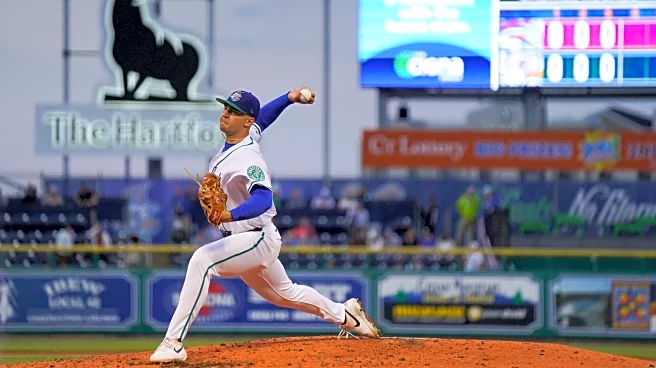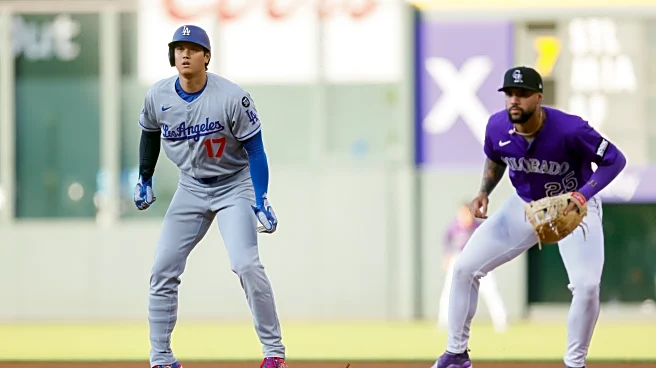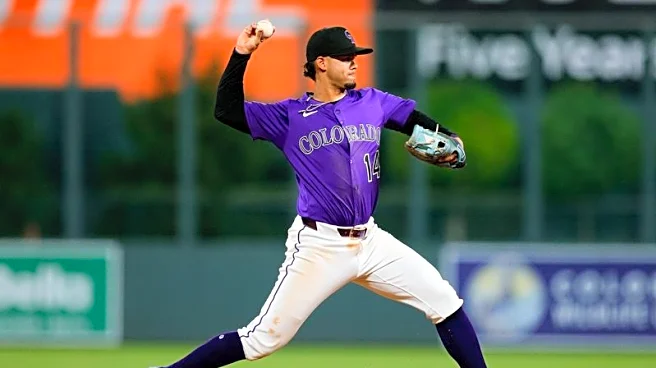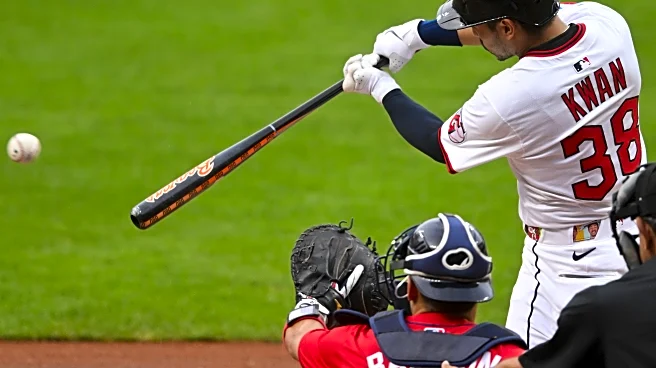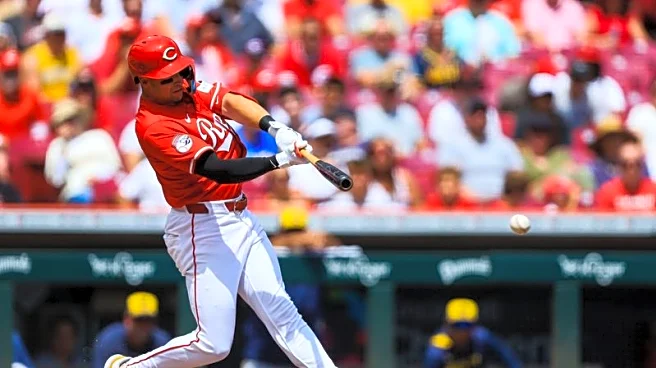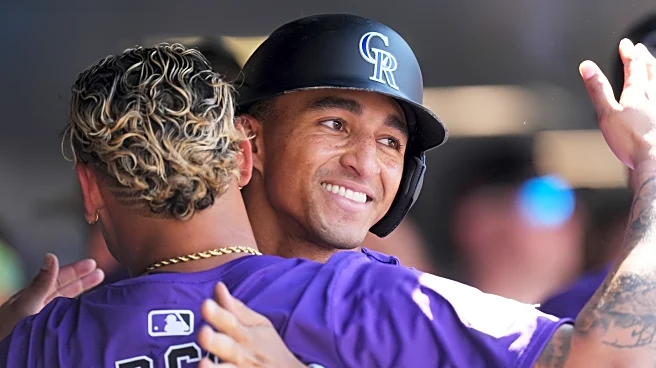
Now we enter the top half of the mid-season 2025 Purple Row Prospects (PuRPs) list. Previously we had PuRPs 30-26, 25-21, and 20-16. As a reminder, in this edition of the PuRPs poll, 23 ballots were cast, with 30 points granted for a first place vote, 29 for second, etc.
For each player on the PuRPs list, I’ll include a link to individual stats and contract status (via Baseball-Reference), PuRPs voting stats, a note on the 2025 season to date, and a scouting report from a national prospect writer
where possible. I’ll also include where I put each player on my personal ballot. All ages are as of the date the article is posted.
15. Max Belyeu (367 points, 23 ballots) — Preseason Ranking: N/A — High Ballot 9, Mode Ballot 14
How did he enter the organization?
2025 Competitive Balance Round B, University of Texas
Why did he make the PuRPs list?
Belyeu (pronounced like the bear in The Jungle Book) was Colorado’s third pick of this year’s draft, going 74th overall and signing for a slot bonus of $1.11 million. Rockies fans will naturally make comparisons between Belyeu and fellow Texas hit-over-power outfielder, Rockies draftee (in 2024’s second round), and PuRP Jared Thomas.
The 6’2” 21-year-old lefty hitting, righty throwing Belyeu handled right field for Texas in 2024 while Thomas (who is only five months older than Belyeu but was old enough to be a draft eligible sophomore) took first base and center field. At Texas, Belyeu didn’t play much as a freshman (only 21 PA) but he broke out in a big way (along with Thomas) in 2024, winning the Big 12 player of the year award. That was on the back of a .329/.423/.667 batting line in 249 plate appearances which included 18 homers among his 34 extra-base hits (142 wRC+). Belyeu followed that up with a relatively punchless .222/.306/.352 summer line in 63 PA in the Cape Cod League while striking out in a third of his plate appearances.
This year, Belyeu moved along with Texas to the tougher SEC as a potential first-round draft pick. He started the season pretty well but in March he suffered a fractured left thumb while diving for a ball in the outfield that limited him to only 156 plate appearances and likely impacted his power output. Belyeu’s .303/.410/.576 line with nine homers among his 17 extra-base hits was still good for a 117 wRC+, but he also struck out over a quarter of the time (up from 17% in 2024) and struggled with chasing out of the zone and spin. Those warts were enough to make him available for the Rockies between the second and third rounds of the draft.
The Rockies recently assigned Belyeu straight to High-A Spokane, where in a small sample he has hit quite well (.318/.429/.647 with three homers in 26 PA, 177 wRC) while splitting time defensively between right and center field at 1.3 years younger than league average age.
Here are some highlights from Belyeu’s draft year with Texas:
What do the scouts say?
MLB Pipeline was higher on Belyeu than every person in the PuRPs electorate, ranking him 7th in the system (he was 34th in their draft rankings), one spot and half a grade ahead of Thomas, as a 50 FV player with a 60 grade on the arm and a 55 on the power:
One of the best all-around offensive players in the college crop, Belyeu can hit for average and power while controlling the strike zone, though he was more aggressive than usual in 2025. He has a quick left-handed swing geared for hard contact, showing the ability to pull pitches for home runs or backspin them out of the park to the opposite field. His ability to put the bat on the ball cuts into his walk totals a bit, and he struggled against non-fastballs with the U.S. collegiate national team, in the Cape Cod League last summer and again with the Longhorns this spring.
Belyeu is a good athlete with average-to-solid speed but doesn’t stand out with his instincts on the bases or in the outfield. He’s inconsistent with his reads and routes, which precludes him from playing center field. His arm is both strong and accurate, so he fits nicely in right.
Eric Longenhagen of FanGraphs is less sanguine on Belyeu, grading him as a 40 FV and ranking him 31st in the system (he was 117th in the draft rankings) with a 60 raw power and 55 bat control grade:
Big 12 Player of the Year as a sophomore with .329/.423/.667 line. Had a spike in strikeouts as a junior. Missed half the year recovering from surgery to repair a fractured thumb, but most of his K’s came prior to the injury. Tough to reconcile 18% K% as soph and 25% as a junior. Didn’t perform on the Cape, so that looms, too. Swing has natural uppercut. Has some pronounced swing-and-miss against heaters elevated away from him. Chases spin. Entered the spring in the mix for a late first rounder pick, but now looks more like a late second to third round corner platoon bat.
Here’s what Keith Law of the Athletic wrote about Belyeu after the draft:
Texas outfielder Max Belyeu (2C) seems like great value at this spot — I had him ranked 41st and the Rockies got him at pick 74 — after his spring was wrecked by a thumb injury that clearly sapped his power following his return. He’s a corner outfielder with above-average pop who needs to tighten up his swing decisions, chasing way too many pitches out of the zone right now. He’s better than what we saw from him this year.
When’s he going to get to the Rockies and how good will he be once he’s there?
I think it’s not too unreasonable to compare Thomas and Belyeu as prospects given the similarity in their provenance, age, and position. Thomas is faster, makes better swing decisions that gets his raw power into games more, and can play both center field and first base. Meanwhile, Belyeu has a better contact tool, raw power, and outfield arm that is well suited for right field. I prefer Thomas as a prospect because the profile has already worked against Double-A pitching and Belyeu’s issues with spin are concerning, but Belyeu is comfortably a 40+ FV player who I ranked 17th on my ballot.
The Rockies will likely send Belyeu back to High-A next spring, but like Thomas did this year, Belyeu could end the year at Double-A with good performance.
14. Griffin Herring (370 points, 20 ballots) — Preseason Ranking: N/A — High Ballot 6, Mode Ballot 10
How did he enter the organization?
2025 Trade, New York Yankees
Why did he make the PuRPs list?
Herring was the headline prospect coming to the Rockies from the Yankees in exchange for Ryan McMahon last month. The 6’2”, 22-year-old lefty pitcher was the Yankees’ sixth-round pick just last year out of LSU as a draft-eligible sophomore, signing for a $798k bonus that was over double the pick’s $340k slot value — the bonus is more akin to a late third-round pick’s slot value. Herring was a key contributor as a freshman to the 2023 National Championship squad as an ace multi-inning reliever despite velocity topping out in the low 90s, then was even more impressive in that role as a sophomore (1.79 ERA, 1.03 WHIP, 12.0 K/9 rate, 2.3 BB/9 rate) in 50 1/3 innings (which was 3rd on the team) across 21 games.
As a professional, the Yankees not only gave Herring the opportunity to start, they remade his delivery and his pitch mix — emphasizing the slider. The result has been a breakout debut professional season. Herring made eight starts in Low-A to begin the year and was dominant, posting a miniscule 1.21 ERA with a 0.9 WHIP and 11.7 K/9 rate in 44 2/3 innings as a league average pitcher. A late May promotion to High-A (where he’s 1.3 years younger than league average) didn’t faze Herring much. He threw eight more strong starts with another 44 2/3 innings, a 2.22 ERA, 1.16 WHIP, 8.9 K/9 rate, and 4.0 BB/9 rate — though his 3.71 xFIP indicated some good fortune.
Since the trade in late July (and through games on Monday), Herring has made three shorter starts for High-A Spokane as the Rockies no doubt are metering his usage considering his lower innings total in 2023 and 2024. In 11 innings, Herring has allowed three runs on six hits and four walks while striking out an impressive 18 hitters. This year so far, Herring has thrown 100 1/3 innings across two levels and three teams with a 1.79 ERA, 1.02 WHIP, 10.8 K/9 rate, and 3.6 BB/9 rate while allowing only a .525 OPS. Impressively, the lefty has been even stingier when batters have the platoon advantage (.472 OPS for righties, .657 OPS for lefties).
Here’s some video of Herring in High-A in a mid June start:
What do the scouts say?
MLB Pipeline is high on Herring, ranking him 9th in the system as a 45 FV player with a 60 grade on the slider:
Herring’s best pitch is a sweeping mid-80s slider with horizontal and vertical action that confounds both lefties and righties. He can’t overpower hitters with his fastball, which operates in the low 90s and tops out at 94 with some armside run, and he’ll need to find more velocity or life against better competition. He threw only 11 changeups at LSU but emphasized the pitch more during three Cape Cod League starts last summer, showing some decent if firm mid-80s cambios with depth.
Herring has a long arm action and a less-than-smooth delivery, though it throws batters’ timing off and didn’t stop him from pounding the strike zone as a sophomore. To succeed as a pro starter, he’ll need to add more strength to his 6-foot-2 frame and improve his fastball and changeup. If he can’t, he still could become a high-leverage reliever thanks to his slider and mound presence.
Longenhagen at FanGraphs ranks Herring 21st in the system as a 40 FV pitcher with a 55 future grade on the slider and command:
The Yankees made several changes to Herrin after drafting him (more sliders, better extension, higher arm slot) and the result looks like a stable backend starter despite 30-grade fastball velocity.
Herring spent two years as LSU’s most consistent long reliever (working as many as five innings) and was a draft-eligible sophomore in 2024. The Yankees made multiple changes to his delivery and pitch usage, which helped him dominate Low-A and earn a promotion after just eight starts. He had a 1.71 ERA combined at both levels at the time of the trade, though his K% dipped quite a bit after he was moved up to Hudson Valley. Herring’s fastball only averages about 90 mph, but lives off deception and riding life. Since turning pro, his arm slot has been raised, but Herring’s stride down the mound has gotten bigger and longer, and his extension was just shy of seven feet at the time of the trade. His loose, whippy arm action prevents hitters from seeing the baseball until release, and despite lacking anything close to average big league fastball velocity, Herring’s heater has generated above-average miss and chase so far this year.
With the Yankees, Herring also emphasized use of his slider, which has become his most-deployed pitch. It ranged from 80-85 mph in his final outing prior to the deal, and has tight late movement but lacks huge depth. It’s playing like an above-average pitch in pro ball. Herring didn’t really have a changeup in college, but he’s added one as a pro and is throwing it about 14% of the time. His feel for it isn’t bad considering he’s just begun using it, but it often cuts on him or finishes too high. A smooth on-mound operator, Herring looks the part of a starter even though he isn’t especially physical because of his mechanical grace. It’s impressive that he’s maintained his excellent college strike-throwing even though his delivery has been changed, and he projects as a high-floored backend starter.
When’s he going to get to the Rockies and how good will he be once he’s there?
Herring joins fellow PuRPs Carson Palmquist and Sean Sullivan as lefty Rockies pitching prospects who use deception and extension to make mediocre fastball velocity play up. I graded all three as 40+ FV players and Herring was 12th on my list, just below Sullivan and above Palmquist. Of the three, Herring has the most traditional starter profile and his slider is a bona fide weapon, but he hasn’t yet proved his effectiveness against upper minors hitting like the other two pitchers have. I expect Herring to get that chance next season in Double-A, with a big league debut possible later in the year if he’s successful and healthy.
13. Ryan Ritter (375 points, 21 ballots) — Preseason Ranking: 17 — High Ballot 7, Mode Ballot 12
How did he enter the organization?
2022 Fourth Round, University of Kentucky
Why did he make the PuRPs list?
Ritter is another PuRP whose rookie eligibility elapsed between the voting period opening and now. Only a recent three week long IL stint due to a hand laceration kept him eligible. At the moment, Ritter is the closest thing the Rockies have to a regular second baseman despite playing only six of his 36 MLB games there. The 6’2” 24-year-old infielder has risen up the minor league ladder by pairing up-the-middle defensive utility with decent power production after the Rockies drafted Ritter in 2022’s fourth round and signed him for a slightly over-slot $530k bonus.
In his first full professional season in 2023, Ritter blew up the Low-A California League to such an extent (35 extra-base hits in 65 games, 162 wRC+) that he was named league MVP despite not playing in the league after July 2nd. A strong stint at High-A followed (121 wRC+), as did a brief cameo in Double-A. Ritter was back in Hartford for 2024 and was productive (126 wRC+) while reducing his strikeouts to 24% of PA despite a month-long IL stint.
Ritter got a 65 plate appearance coda in the Arizona Fall League as well, producing a Three True Outcome-heavy .150/.477/.350 line with 18 BBs (28% of PA), 19 Ks (29%), and two HR (3%) accounting for over 60% of outcomes. That’s not including the seven (!!!) times he was hit by pitch (11% of PA). Ritter was hit by 16 pitches in Hartford as well, and the 23 combined HBP would have led all of MLB. While some offensive questions with Ritter were answered in 2024, more scouting reports (see below) placed doubts on his ability to stick at shortstop and he began to appear more at second base a bit more in the AFL.
This year, Ritter jumped up to Triple-A Albuquerque and fit right into the Pacific Coast League, hitting .303/.405/.610 with 16 homers among his 32 extra-base hits in just 260 plate appearances, good for a 137 wRC+. He did that while lowering his strikeouts further to 21% of PA and increasing his walks to 13% (up from 9% the year before). For a Rockies team that had lost starting shortstop Ezequiel Tovar to an extended injury absence and had cycled through some band-aid solutions, Ritter was a good option and had his contract selected by the Rockies in early June and was called up to the Show.
Given the dire need at shortstop, Ritter was immediately an everyday player for the Rockies. He got a hit in his first six games with Colorado, including two triples, but he didn’t homer until game number 28 in mid-July. That’s still the only big league homer for Ritter, who has five doubles and three triples in 127 plate appearances en route to a .252/.297/.370 batting line while striking out 29% of the time. He’s been more effective against left-handed pitching, with a .780 OPS against them vs. .641 against right-handers. Ritter’s decent defense (five errors in 35 games) at shortstop and second base has mitigated the detrimental effects of the 71 wRC+, totaling 0.4 rWAR to date (12th on the team).
The video of Ritter below from the AFL is emblematic of his time there — lots of patience, some HBP, one ball in play, and a good defensive play at the end:
What do the scouts say?
Eric Longenhagen of FanGraphs is a skeptic of Ritter’s shortstop defense, consigning Ritter to the 35+ FV section, 36th in the system:
Ritter does some acrobatic stuff at shortstop but, even at age 24, he needs technical polish. He’s well-built and mobile enough to continue to develop at short, but a lot of what he does there takes a little too long, and scouts’ opinions of Ritter’s defense are all over the map. Ritter has good power for a middle infielder but looming issues against sliders, including ones that finish in the zone, have me stopping short of projecting him for enough offense to be a good team’s utilityman. Instead, he’s a bottom-of-the-40-man type whose athletic longevity and power should keep him in that area for a while.
Providing the more optimistic view is MLB Pipeline, who classified Ritter as a 45 FV prospect with plus grades on his arm and fielding ability, and ranked him 12th in the system before his rookie eligibility expired:
Nothing has changed in terms of what people think Ritter can do defensively. He should be able to play shortstop for a long time with an excellent combination of athleticism and instincts. He has outstanding actions and field awareness with a plus arm that can make throws from anywhere.
At Kentucky, Ritter never got to a point where he was consistently impacting the baseball, even though there was raw power waiting to be unlocked. There were glimpses during his pro debut in the Arizona Complex League, but it was all to his pull side and the Rockies have worked with him to formulate more of an approach at the plate to drive the ball to the right-center-field gap, especially on fastballs, which in turn is helping him recognize spin more consistently. He’s incorporating the athleticism seen at shortstop into the batter’s box with positive outcomes. If he can continue his transition from swinger to hitter, he has the chance to be more than just a utility-type at the highest level.
Keith Law of the Atlantic ranked Ritter 16th in his pre-season system commentary:
Ritter’s a quality big-league utility infielder, a smart and instinctive player whose only above-average tools are on defense and no projection from here. He hit .270/.370/.403 last year as a 23-year-old in Double A, with the OBP inflated by 16 HBP; his walk rate was just 9.4 percent. He’s got 45 power, maybe, and a 50 hit tool, enough to make contact at a high enough rate to stick on a major-league bench. He’s a 55 defender at short, again more on instincts and reads than athleticism, with plenty of arm to handle short and third.
John Trupin of Baseball Prospectus listed Ritter as a “person of interest” in his preseason system ranking:
Decent all-around athleticism and a high-motor play style helps Ritter outperform his measurables, as he’s been a highly efficient base stealer despite somewhat pedestrian sprint speed for a middle infielder. His physicality allows him to muscle up the baseball despite a compact swing that is primarily geared for line drives. His range falls short at times of what’s expected for a big-league shortstop, and despite smooth athleticism and a strong arm, he’s better served as a strong second or third baseman. He’ll likely play a bit of all three by the time he makes the bigs.
When’s he going to get to the Rockies and how good will he be once he’s there?
As Ritter’s numbers this year have shown, he doesn’t need to be an impact offensive player to be a useful big leaguer if he can be a strong defender. Add in Ritter’s plate discipline improvements and strong offensive performance in the upper minors and I think he’s a 40 FV player who I ranked 22nd in the system.
Ritter looks like he’ll stick around the big league club for a while in some capacity and will probably vie for the starting second base job with Adael Amador and others next spring (he’ll probably be a primary option there down the stretch this year). On a playoff contender, a player like Ritter would be a good utility infielder option. On the Rockies, he’s been one of the more valuable players on the team since his call-up in June.
12. JB Middleton (375 points, 23 ballots) — Preseason Ranking: N/A — High Ballot 10, Mode Ballot 11
How did he enter the organization?
2025 Second Round, University of Southern Mississippi
Why did he make the PuRPs list?
Middleton became the highest ever drafted pitcher for Southern Mississippi when the Rockies took him 45th overall in the 2025 draft (Middleton was 41st in MLB Pipeline’s draft ranks), signing the 21-year-old right-hander to a $2.072 million bonus that was $100k under slot. Middleton doesn’t possess ideal size for a modern day hurler (he’s only 6’0”), but his repertoire includes a good three pitch mix (fastball, slider, change) that he throws for strikes.
Middleton’s freshman year in 2023 wasn’t pretty (nine earned runs in 9 1/3 innings), but he became an important reliever in 2024 for USM, throwing 37 1/3 innings with a 4.34 ERA, 1.47 WHIP, 10.8 K/9 rate, and 6.0 BB/9 rate. Middleton’s stuff took a big step forward in 2025 and he moved into an ace starter’s role. In 16 starts, Middleton averaged nearly 6 2/3 innings per outing (105 1/3) against less acclaimed competition in the Sun Belt conference. Middleton’s 2.31 ERA, 10.4 K/9 rate, and 2.1 BB/9 rate were good, but it was his sterling 0.85 WHIP (ranking second in Division I) that was especially noteworthy.
Here’s video of Middleton in action this March with USM courtesy of Kyler Peterson, including some slo-mo looks at his delivery and release for his arsenal in the last couple minutes:
What do the scouts say?
MLB Pipeline is more hyped about Middleton than the PuRPs electorate, ranking him 6th as a 50 FV player with a 60 grade on both the fastball and slider as well as a 55 on the changeup:
Middleton works with a versatile 93-95 mph fastball that tops out at 97, showing the ability to run and sink it toward the knees or carry it up at the letters. He gets plenty of swings-and-misses in the zone, elicits lots of chases and makes it nearly impossible to lift his heater in the air. His slider is even harder to hit, combining upper-80s velocity with two-plane depth, and he’ll morph it into a cutter at times.
Middleton will also flash a plus 86-88 mph changeup that tumbles and fades and gets in-zone misses and chases like his other offerings. He has an athletic delivery, moves down the mound well and cut his walk rate in half compared to last season. His lack of physicality is the only real knock against him as a long-term starter, though his improved strikes and stuff are stronger points in his favor.
Longenhagen at FanGraphs is less optimistic, grading Middleton as a 40 FV player and ranking him 25th in the system with a 60 future grade on the changeup:
Undersized righty who moved into Southern Miss rotation this year and held 94-95 mph heaters through well over 100 innings, touched 97 in final start of the year. Fastball lacks great life, curt upper-80s slider often looks like more of a cutter but played like a plus pitch in terms of miss in 2025. Turns over a power-tailing changeup in the mid-80s that looks more obviously plus to the eye. Will show you some pitchability elements (slider/fastball sequencing at top of zone) and was a drastically improved strike-thrower in 2025, but size and meat-of-zone locations point more toward a long relief role.
This is what Keith Law of the Athletic wrote about Middleton after the draft:
Right-hander JB Middleton (2) is a high-probability back-end starter, up to 97 with a four-pitch mix. He has plus control to make up for the lack of a clear out-pitch and the weapons to get right- and left-handed batters out. He’s a good candidate for some pitch design help, whether it’s to tweak the slider to get more bite to it or help him add a new pitch, as the delivery really works and he throws a ton of strikes.
When’s he going to get to the Rockies and how good will he be once he’s there?
Middleton has yet to make his professional debut, which isn’t surprising given the workload he had this year. I’d expect him to begin next year in High-A after an offseason of the Rockies working with him on pitch design. He’s a high-probability starting pitcher with a mid-rotation projection, which is always a big need for the Rockies, though I’d like to see his 2025 results carry over into pro ball before I rank him where MLB Pipeline has him in the system. For me, Middleton is a 40+ FV player that I ranked 14th on my list.
11. Gabriel Hughes (378 points, 21 ballots) — Preseason Ranking: 11 — High Ballot 2, Mode Ballot 13, 15
How did he enter the organization?
2022 First Round, Gonzaga University
Why did he make the PuRPs list?
Hughes is now over two years removed from a Tommy John surgery that cut a promising first full professional season short for Colorado’s first pick in 2022 (10th overall with an under-slot $4 million bonus). The 6’4” right-hander (who turns 24 later this week) was ranked more as a late-first rounder than a top-10 pick by national prospect watchers at the time, but the Rockies obviously liked the starter’s frame, feel for pitching and the three pitch mix. The former two-way player has a fastball that sits in the low-mid 90s and a bulldog mentality that has been compared to Max Scherzer (you can see some of that in the video below).
Hughes had pitched well in High-A in his first full professional season in 2023. He threw 37 2⁄3 innings across eight starts with a 5.50 ERA (3.48 xFIP), 1.20 WHIP, 12.9 K/9 rate, and 3.6 BB/9 rate. The xFIP and high K/9 rate indicate better stuff than the raw results delivered, and the Rockies agreed by promoting Hughes to Double-A Hartford in early June. Hughes was 3.4 years younger than league average, but he mostly held his own, even if the ERA didn’t bear that out. In 29 innings over six starts, Hughes had a 7.14 ERA but a 4.06 xFIP with a 1.55 WHIP, 9.0 K/9 rate, and 3.4 BB/9 rate for Hartford. It was a good first full professional season for Hughes, but unfortunately it ended due to the injury that necessitated Tommy John surgery.
Hughes rehabbed the injury throughout the 2024 season but was able to make Colorado’s Arizona Fall League roster. He started six games, throwing 17 1⁄3 innings with a 8.31 ERA, 1.73 WHIP, 7.3 K/9 rate, and 5.2 BB/9 rate. The numbers weren’t impressive, but scouts at the AFL reported his stuff had largely returned post-surgery and he was working on developing his breaking balls.
This season, Hughes returned to Hartford, where he was still 1.8 years younger than average. In nine starts there, Hughes got good results in short bursts (he was limited to five innings per start), throwing 41 innings with a 3.07 ERA, 0.85 WHIP, 7.7 K/9 rate, and 1.8 BB/9 rate — earning him a late May promotion to Triple-A Albuquerque.
In the tough PCL, Hughes faced an uphill climb. In eight starts there, he (as expected) posted worse run prevention numbers across the board (6.75 ERA, 1.81 WHIP, 6.2 K/9 rate, 4.5 BB/9 rate) in 32 innings. These starts were interrupted by a month-long IL stint between mid June and late July. Since returning, Hughes has ramped up his pitch count but hasn’t gone deep into games yet.
Here’s some video on Hughes from 2024 instructs and the AFL courtesy of FanGraphs:
What do the scouts say?
In the report accompanying the above video, Eric Longenhagen of Fangraphs grades Hughes as a 40 FV player (down from 45 preseason), 19th in the system with a 55 future grade on the changeup and a 50 future grade on command:
Hughes attacks with a 93-94 mph fastball that often has a little bit of natural cut. His breaking stuff has plateaued; his 85-88 mph slider/cutter is average and lives off of his command, while his 79-82 mph curveball is well below average. Toss out Hughes’ surface-level AFL stats because he was clearly working on this curveball a ton during that stretch. His changeup, a tailing upper-80s offering, is getting better and might be his best pitch at peak. It often has enough tail to run off the front hip of lefty batters and back into the zone. Hughes’ prototypical size, athleticism, and arm action augur more changeup growth, as well as strikes and efficient innings. Hughes won’t be dominant, and I’m perhaps not appreciating how homer prone he’ll be sitting 93 in Colorado, but he should work efficiently and eat innings enough to be a team’s no. 4/5 starter during the regular season.
MLB Pipeline ranks Hughes 16th on the system list as a 45 FV player with a 55 slider grade to pair with 50 grades on the fastball, curveball, and control:
When he’s healthy, Hughes brings an intriguing combination of size and stuff — with feel for it — to the mound. Even right before the elbow injury in Double-A last year, he was up to 97 mph with his fastball, though he sat at around 93. His short and hard mid-80s slider, that has cutter-like action to it, flashes plus and he’s shown feel to spin an effective upper-70s curve as well. He has an 87-88 mph changeup as well, but it’s clearly a fourth pitch.
Hughes uses an up-tempo delivery and goes right after hitters. He can sometimes run into timing issues and there’s unintentional cut on his fastball occasionally, and both can impact his command, though he’s generally around the strike zone.
John Trupin of Baseball Prospectus ranked Hughes 15th in the preseason:
At his healthiest, Hughes has looked like an efficient, mid-rotation workhorse, befitting his 10th overall selection in the 2022 draft. That’s meant low to mid-90s fastballs and a medley of off-speed that all plays up thanks to plus command. That all evaporated in mid-2023, as Hughes saw his velocity and stuff fall off, a sure sign of concerns that led ultimately to the surgeon’s table. Out recovering and rehabbing all of 2024, Hughes can hopefully return to the mound in full in 2025. He’ll have plenty of company in the rehabbing circuit, with several of the most promising arms in the system making their way back from TJ alongside him. His physicality and athleticism is encouraging in spite of the surgery, as the 6-foot-4 righty has the frame to flesh out a more durable existence.
Keith Law of the Athletic recently listed Hughes as a player of note:
[Hughes] pitched in the AFL but it wasn’t great, as his command was way off and he gave up too many walks and hard contact. He’s fastball/slider and pitches with such energy that it might be a better fit for him to move to the bullpen if the command doesn’t improve with another offseason of rest.
When’s he going to get to the Rockies and how good will he be once he’s there?
Hughes is a starting pitcher prospect with good upside and pedigree, though he probably won’t be a star. His Hartford performance is encouraging and his experience so far in Albuquerque is understandable given how he’s working to fully trust his stuff post-surgery. He’ll be Rule 5 eligible after the season and is a likely addition for the Rockies to the 40 man roster. Hughes will be a candidate for what looks like a pretty barren Rockies rotation next spring. The proximity, pedigree, and results led me to grade Hughes as a 40+ FV player and rank him 15th on my list.
Tomorrow, we get into the top ten of the mid-season 2025 PuRPs list!
